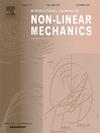随机载荷作用下非线性气动弹性系统能量收集的研究
IF 2.8
3区 工程技术
Q2 MECHANICS
International Journal of Non-Linear Mechanics
Pub Date : 2025-07-02
DOI:10.1016/j.ijnonlinmec.2025.105193
引用次数: 0
摘要
人们对从气动弹性振荡中获取能量越来越感兴趣,其目标是使一些小型动力装置能够自给自足。虽然在了解简洁的气动弹性能量收集所需的最佳参数范围方面取得了相当大的成功,但将这些发展转化为现场条件却充满了困难。在现场条件下普遍存在的一个突出挑战是环境风波动的存在。这些风的波动通常是随机的,并在不同的空间和时间变量尺度上变化。此外,从空气动力学的角度来看,这些随机风波动可以是轴向的,即,沿翼型弦线的方向,或可以在垂直方向,即,垂直于翼型弦线。前者产生乘性噪声,后者产生对现有动力系统(翼型)的加性噪声。在这些随机阵风下的能量收集潜力在迄今为止的文献中很少被探索,而且远未完成。解决这个问题是本研究的关键焦点。为此,考虑了俯仰刚度具有三次硬化非线性的俯仰倾缩型。压电换能器(PZT)附着在翼型的弹性轴上。采用数值方法求解了受随机风波动影响的气动弹性系统,确定了系统的输出电压和输出功率。作为第一步,提出了确定性分岔情景,以及能量收集潜力。然后给出了纵向湍流、垂直湍流以及纵向和垂直组合湍流下的能量收集势。结果表明,垂直湍流,特别是产生连续振荡,甚至低于所谓的颤振速度,实现有效的能量收集能力不同于其纵向对应。考虑到垂直阵风和各种气动弹性装置的普遍存在,本研究的结果强调了各种湍流组件对功率输出的影响,同时为优化实际应用中的能量收集提供了见解。本文章由计算机程序翻译,如有差异,请以英文原文为准。
Investigation into energy harvesting from a non-linear aeroelastic system subjected to stochastic loads
There is growing interest to harvest energy from aeroelastic oscillations — with the goal of making several small power devices self-reliant. While a considerable success has been achieved in understanding the optimal range of parameters required for succinct aeroelastic energy harvesting, translating these developments to in-field conditions is fraught with difficulties. A prominent challenge that is ubiquitous in in-field conditions is the presence of ambient wind fluctuations. These wind fluctuations are often random and vary across different scales of spatial and temporal variables. Further, from an aerodynamic point of view, these stochastic wind fluctuations could either be axial, i.e., along the direction of the chord line of the airfoil, or could be in the vertical direction, i.e., perpendicular to the chord line of the airfoil. The former gives rise to a multiplicative noise, and the latter yields to be an additive noise to the existing dynamical system (airfoil). The energy harvesting potential under these stochastic wind gusts is minimally explored in the hitherto literature and are far from complete. Addressing this end-of-concern forms the pivotal focus of this study. To that end, a pitch–plunge airfoil with cubic hardening nonlinearity in the pitch stiffness is considered. A piezoelectric transducer (PZT) is attached to the elastic axis of the airfoil. A numerical approach is used to solve the aeroelastic system coupled with an energy harvesting mechanism undergoing stochastic wind fluctuations to determine the voltage output and the harvested power. As a first step, the deterministic bifurcation scenario, along with the energy harvesting potential, is presented. Subsequently, the energy harvesting potential under longitudinal turbulence, vertical turbulence, and combined longitudinal and vertical turbulence is provided. Results indicate that vertical turbulence, in particular, produces continuous oscillations even below the so-called flutter velocity, enabling effective energy harvesting capabilities unlike its longitudinal counterpart. Given the ubiquitous presence of vertical wind gusts and a variety of aeroelastic devices, the findings from this study underscore the impact of various turbulence components on power output, along with offering insights into optimizing energy harvesting for real-world applications.
求助全文
通过发布文献求助,成功后即可免费获取论文全文。
去求助
来源期刊
CiteScore
5.50
自引率
9.40%
发文量
192
审稿时长
67 days
期刊介绍:
The International Journal of Non-Linear Mechanics provides a specific medium for dissemination of high-quality research results in the various areas of theoretical, applied, and experimental mechanics of solids, fluids, structures, and systems where the phenomena are inherently non-linear.
The journal brings together original results in non-linear problems in elasticity, plasticity, dynamics, vibrations, wave-propagation, rheology, fluid-structure interaction systems, stability, biomechanics, micro- and nano-structures, materials, metamaterials, and in other diverse areas.
Papers may be analytical, computational or experimental in nature. Treatments of non-linear differential equations wherein solutions and properties of solutions are emphasized but physical aspects are not adequately relevant, will not be considered for possible publication. Both deterministic and stochastic approaches are fostered. Contributions pertaining to both established and emerging fields are encouraged.

 求助内容:
求助内容: 应助结果提醒方式:
应助结果提醒方式:


